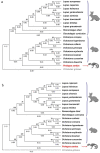Ancient DNA re-opens the question of the phylogenetic position of the Sardinian pika Prolagus sardus (Wagner, 1829), an extinct lagomorph
- PMID: 37604894
- PMCID: PMC10442435
- DOI: 10.1038/s41598-023-40746-w
Ancient DNA re-opens the question of the phylogenetic position of the Sardinian pika Prolagus sardus (Wagner, 1829), an extinct lagomorph
Abstract
Palaeogenomics is contributing to refine our understanding of many major evolutionary events at an unprecedented resolution, with relevant impacts in several fields, including phylogenetics of extinct species. Few extant and extinct animal species from Mediterranean regions have been characterised at the DNA level thus far. The Sardinian pika, Prolagus sardus (Wagner, 1829), was an iconic lagomorph species that populated Sardinia and Corsica and became extinct during the Holocene. There is a certain scientific debate on the phylogenetic assignment of the extinct genus Prolagus to the family Ochotonidae (one of the only two extant families of the order Lagomorpha) or to a separated family Prolagidae, or to the subfamily Prolaginae within the family Ochotonidae. In this study, we successfully reconstructed a portion of the mitogenome of a Sardinian pika dated to the Neolithic period and recovered from the Cabaddaris cave, an archaeological site in Sardinia. Our calibrated phylogeny may support the hypothesis that the genus Prolagus is an independent sister group to the family Ochotonidae that diverged from the Ochotona genus lineage about 30 million years ago. These results may contribute to refine the phylogenetic interpretation of the morphological peculiarities of the Prolagus genus already described by palaeontological studies.
© 2023. Springer Nature Limited.
Conflict of interest statement
LF is member of the editorial board of Scientific Reports. The authors declare no other competing interests.
Figures




Similar articles
-
Evolutionary history of the extinct Sardinian dhole.Curr Biol. 2021 Dec 20;31(24):5571-5579.e6. doi: 10.1016/j.cub.2021.09.059. Epub 2021 Oct 15. Curr Biol. 2021. PMID: 34655517
-
Ochotona princeps (pika) myoglobin: an appraisal of lagomorph phylogeny.Proc Natl Acad Sci U S A. 1982 Mar;79(6):1917-20. doi: 10.1073/pnas.79.6.1917. Proc Natl Acad Sci U S A. 1982. PMID: 6952242 Free PMC article.
-
Auditory region circulation in Lagomorpha: the internal carotid artery pattern revisited.Philos Trans R Soc Lond B Biol Sci. 2023 Jul 3;378(1880):20220088. doi: 10.1098/rstb.2022.0088. Epub 2023 May 15. Philos Trans R Soc Lond B Biol Sci. 2023. PMID: 37183894 Free PMC article.
-
LaGomiCs-Lagomorph Genomics Consortium: An International Collaborative Effort for Sequencing the Genomes of an Entire Mammalian Order.J Hered. 2016 Jul;107(4):295-308. doi: 10.1093/jhered/esw010. Epub 2016 Feb 26. J Hered. 2016. PMID: 26921276 Free PMC article. Review.
-
The pikas of China: a review of current research priorities and challenges for conservation.Integr Zool. 2023 Jan;18(1):110-128. doi: 10.1111/1749-4877.12615. Epub 2022 Jan 21. Integr Zool. 2023. PMID: 34937133 Review.
Cited by
-
Museomics and morphological analyses of historical and contemporary peninsular Italian wolf (Canis lupus italicus) samples.Sci Rep. 2025 Feb 4;15(1):4232. doi: 10.1038/s41598-024-84319-x. Sci Rep. 2025. PMID: 39905114 Free PMC article.
References
Publication types
MeSH terms
Substances
LinkOut - more resources
Full Text Sources

